Shakhtar Donetsk and Inter Millan both share a commonality as they enter the new football campaign with a brand-new manager at the helm, Shakhtar hiring former Sassuolo manager Roberto Di Zerbi and Inter employing ex Lazio manager Simone Inzaghi. Two Italian managers going head-to-head in a Champions League clash playing a style of football that is not synonymous in Italy. Inter currently sit top of Serie A while scoring the most goals within the division while Di Zerbi’s Shakhtar sits second within the Ukrainian Premier League and scoring 23 goals in 9 matches. Both teams have a clear way of playing which utilises clever positional play in and out of possession and strategic transitions that allow them to excel which makes this game an interesting match-up between team and manager.
This tactical analysis will showcase some of the intricacies of Di Zerbi’s Shakhtar with the ball and how they tried to create opportunities while limiting Inter’s attacking thrust that has helped them reach the top of the Italian table. The article will also explore how Pedrinho faired playing as a striker for the Ukrainian outfit and the positives and the negatives of occupying the striker position. Lastly, we will look at how Inter tried to disrupt Shakhtar and remained defensively strong without controlling possession. This draw between the two teams serves Sheriff Tiraspol and to a lesser degree, Real Madrid but it cannot be considered as a positive result for any of the two teams of Group D.
Line-ups
Inter visited Ukraine using their standard 3-1-4-2 formation with club captain Samir Handanović in goal, Milan Škriniar, Stephen De Vrij and Alessandro Bastoni forming a back-three. Federico Dimarco and Denzel Dumfries were stationed at wing-back while Nico Barella, Marcelo Brozović and Matías Vecino played in centre midfield. Lautaro Martínez and former Manchester City’s Edin Džeko were the striker-partnership of choice for this game.
Shakhtar Donetsk made use of a 4-2-3-1 formation with veteran goalkeeper Andriy Pyatov, Ismaily, Marlon, Mykola Matviyenko and Dodo in defence. Taras Stepanenko, Maycon, Alan Patrick, Manor Solomon and Pedrinho played in midfield with Lassina Traore leading the line as a lone striker.

Shakhtar’s build-up variations
As mentioned above, Shakhtar lined up in a 4-2-3-1 formation but when in possession during the first phase of play some things changed. During these moments, Shakhtar progressed to play with four at the back at times with fullbacks Ismaily and Dodo positioned narrowly. Another common thread was their use of a back-three with Taras Stepanenko dropping between the central defenders and Maycon playing as a lone defensive midfielder. The forming of a back three was useful in many ways as it allowed both fullbacks to push up and affect the game in attacking areas while also creating numerical superiority during certain sequences.
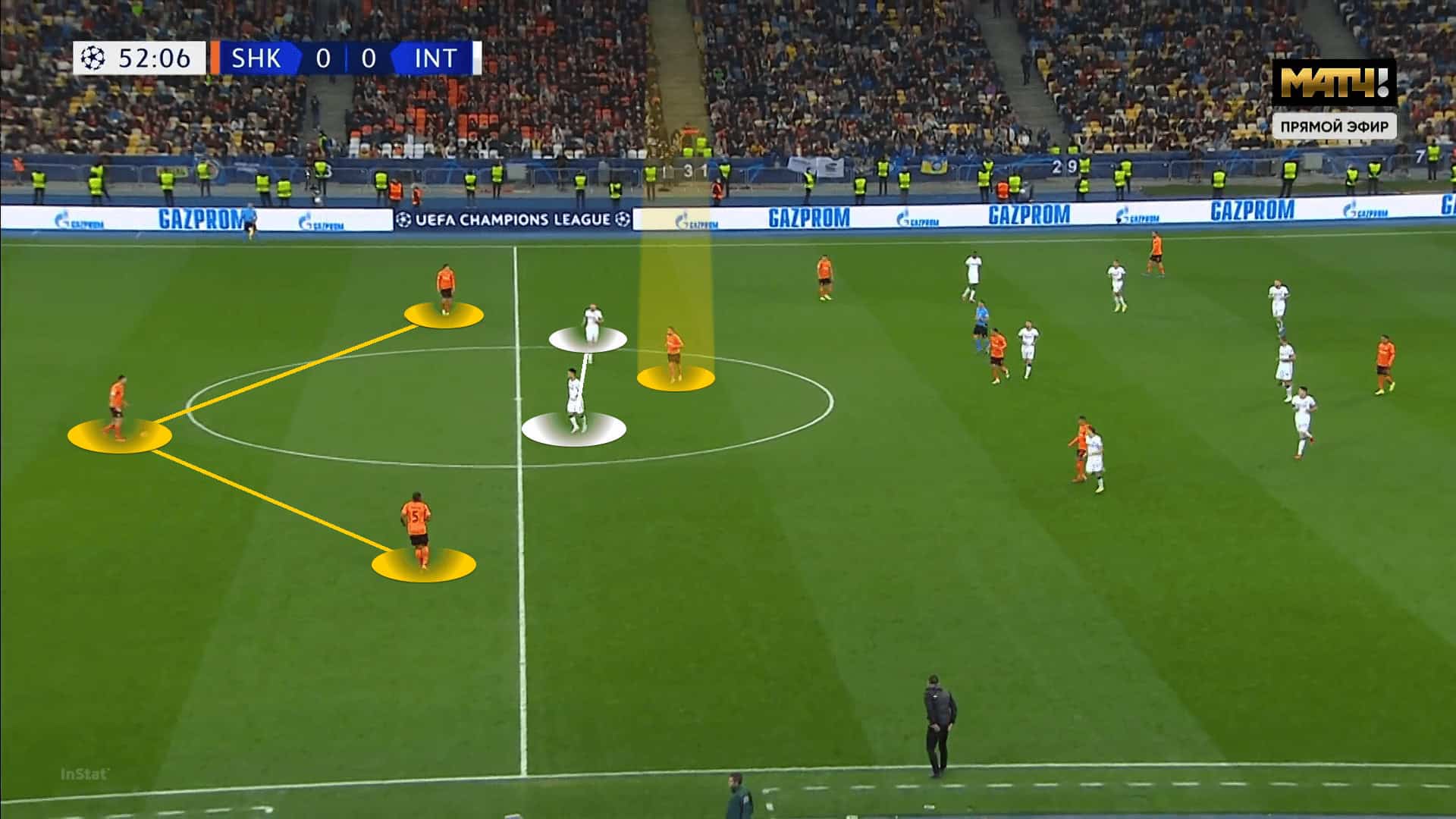
Overall, Shakhtar’s main aim during this match was to play vertically and make transitions quickly with good passing combinations. One aspect that was especially interesting about their play was how players created space for each other with their use of countermovement so that they can create an open passing option and how they created openings in the final third. A good example of this would be on the right-hand side of the field, mainly during the second half.
Tete was positioned on the wing while the right-back Dodo was operating in the right half-space which may seem odd on the first view but there is a method to Di Zerbi’s madness. Dodo is a sharp and direct runner with technical ability which makes him a threat to the opposition and because of this, he can drag Inter players into certain directions. At times he would vacate the half-space and run into wing positions and in doing so, he creates space for the Brazilian winger Tete to exploit that in central areas.
Pros and Cons of Pedrinho as a striker
Lassina Traore was the starting striker at the beginning of this game but during the eleventh minute, he suffered a severe injury which led to the introduction of Tete. This led to moving Pedrinho from the wing to the centre striker role. During his time occupying this position, there were some instances where he excelled. With Pedrinho you have a player with an abundance of technical ability who uses his body orientation well to beat the press from the opposition.
Also, he is a player who can be used as an out-ball with his back to goal and aid ball progression while bringing teammates into play. These skills outlined was on full display against Inter. Having a player like him in this role going up against a strong Inter team has its upsides and downsides positionally as Pedrinho is not naturally a striker.
So, his instincts are to come deep and support his midfield counterparts. This can be useful as Shakhtar want to progress the ball vertically and have an extra free body in midfield who can aid in applying their tactical blueprint. On the other hand, his constant habit of coming deep comes to a detriment to his team.
Throughout the game, Shakhtar accumulated 12 shots but only three were on target with a success rate of 25% which is a poor showing for all the control they obtained during the match. The reasoning behind this poor final third performance is due to the lack of threat within the Inter Milan box from Shakhtar. Pedrinho recorded three shots on the night which at first glance did not sound like a terrible output from a striker, but all of his shots were off target and only one of his chances was taken in the box, in addition, his lack of running in behind created a knockoff effect of his teammates taking low-quality shots due to the lack of options upfront.
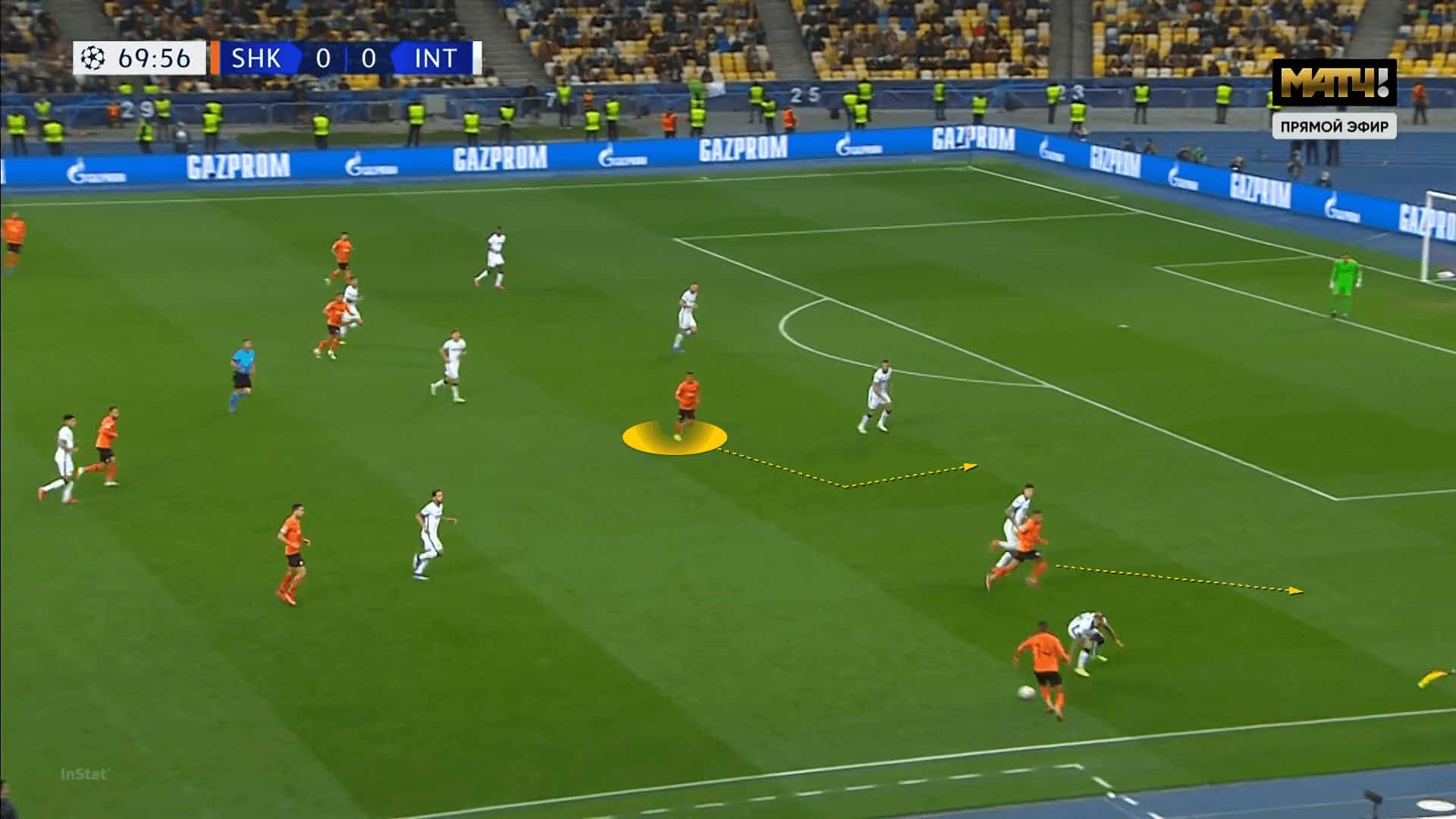
Inter Milan’s defensive shape
During this match, Inter Milan were not able to impose their attacking style in Ukraine as Shakhtar’s high pressing scheme was effective. Saying this, Inter were still able to stay strong defensively and claim a point away from home. Out of possession, Inter remained in their standard 5-3-2 shape which they utilised during the first half a high press but resorted to a sturdy mid-block.
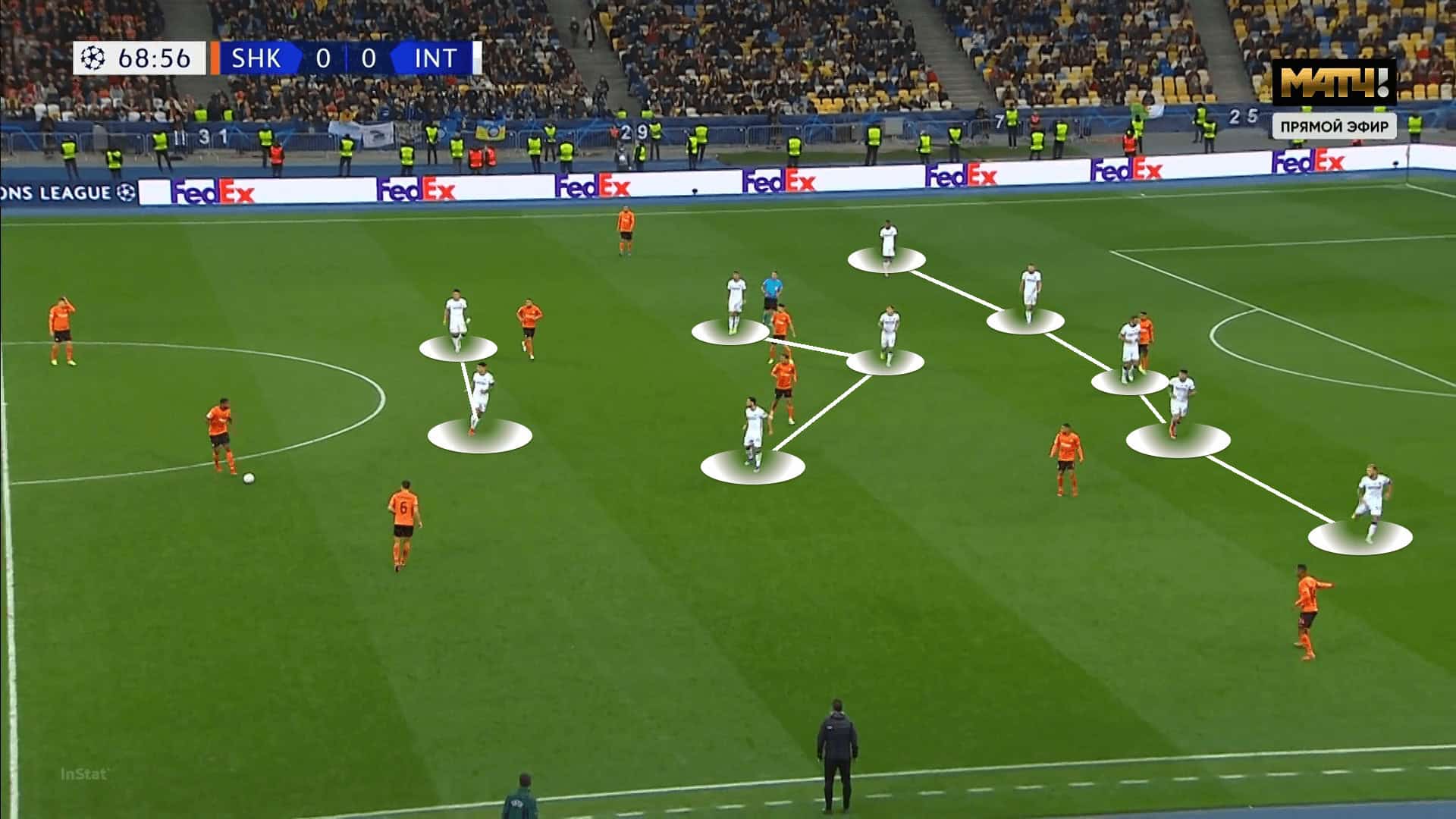
For Shakhtar, both Dodo and Manor Solomon were positioned in the half-spaces to create central passing lanes and to combat this Alessandro Bastoni and Milan Skriniar were granted the freedom to marshal these areas and press aggressively at times in Shakhtar’s side of the pitch to condenses the space and to negate the threat of the opposition. This use of Inter’s outside centre-backs paid dividends as they were able to hold on and remain strong for the duration of the game.
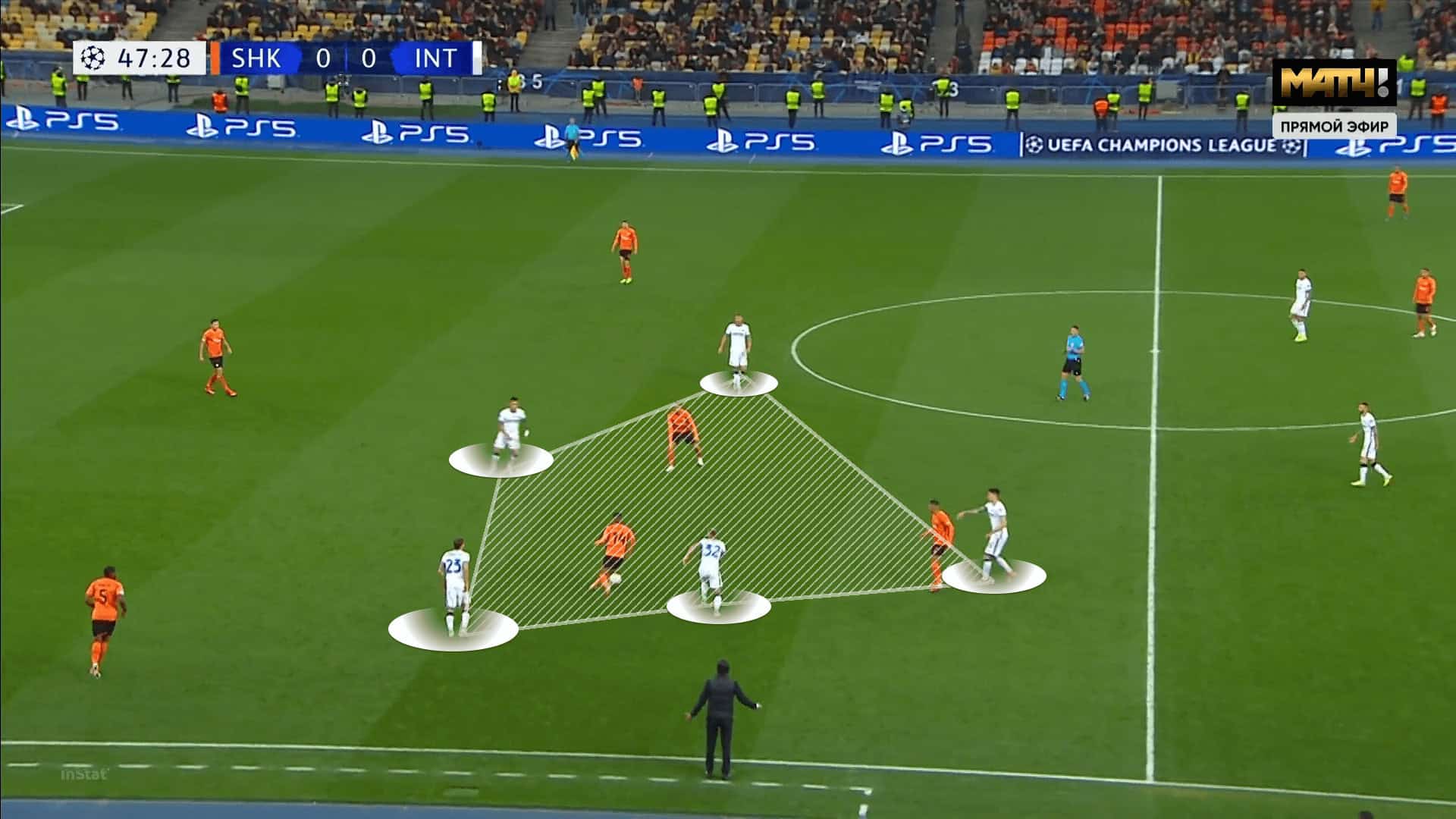
Conclusion
Regardless of the 0-0 scoring, many takeaways can be pulled from this game, for one, Shakhtar under Di Zerbi have a clear plan regarding his tactics, which is pretty on the eye when observing. However, Shakhtar does have some chance creation problems which may look worse with the lack of a real central striker leading the line in this European tie.
For Inter, they were not able to showcase their attack prowess as they could not cope with Shakhtar’s 4-2-3-1 high pressing system out of possession. Saying this, to have the ability to play away in the UEFA Champions League in a tough stadium and still leave with a draw should be appreciated given the opponent’s impressive defensive display but if they wish to progress further in the competition, an offensive improvement is needed.

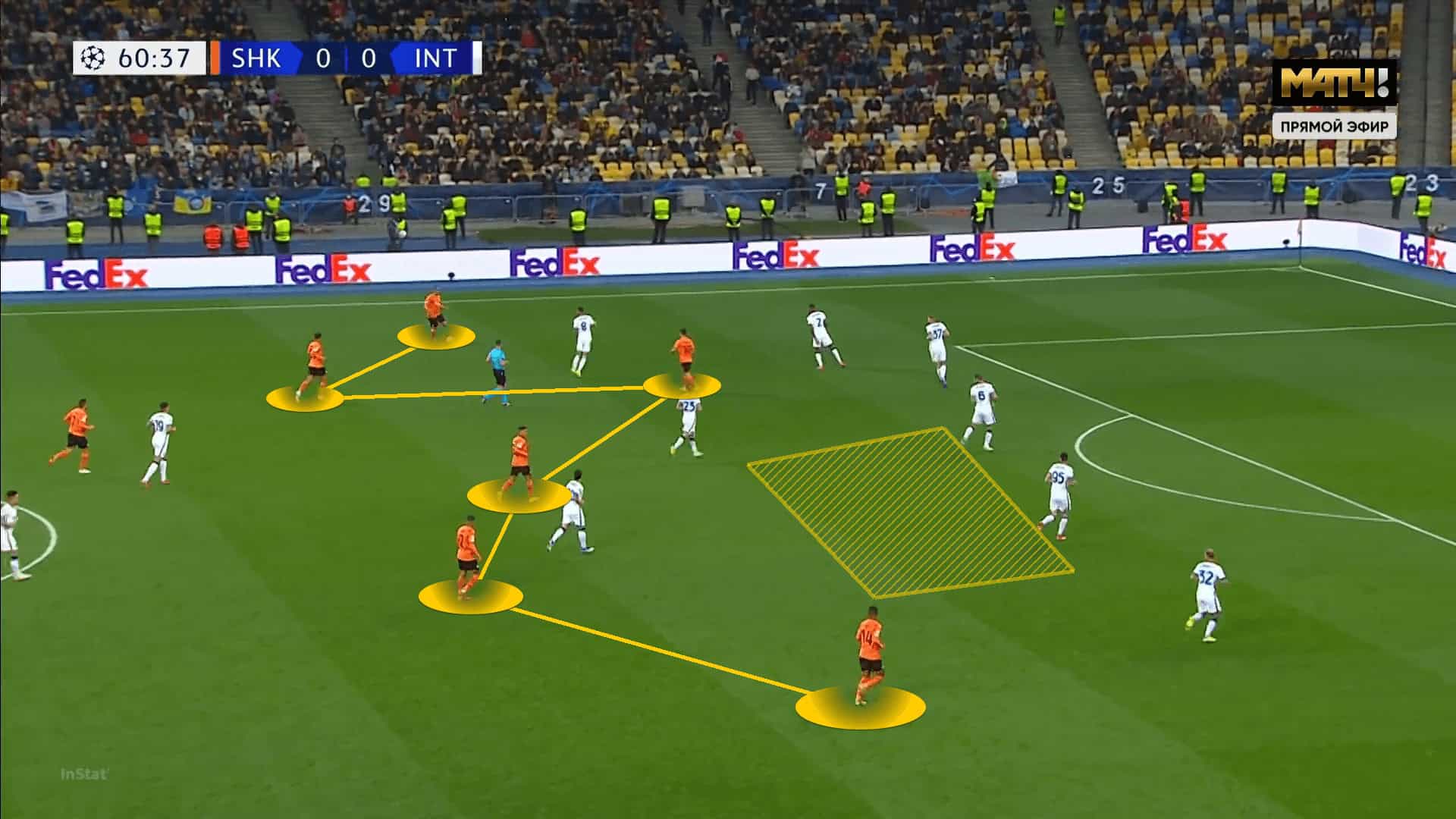



Comments